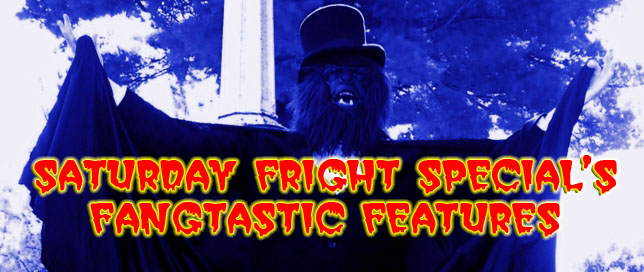
Reviewed by Rick Trottier
One of the reasons readers enjoy short story collections is that it’s a little like going to a wine tasting party, you get lots of small sips of fine vintages that give you a sense of the splendid flavors and the bouquet of each bottle. Short stories are a lot like that, for they provide the literature lover a brief glance at a concept or a fleeting surge of emotion. Most of the time, motion pictures do not cross into such territory for a wide variety of reasons, most commonly that film is expensive and telling a series of brief tales is not always a successful commercial choice for a movie. Horror anthologies proved that such a cinematic style can be financially successful, but even then the vast majority of anthology installments are lengthier in proportion to what a film-version of a short story would be. THE MANIACS (I MANIACI) is a notable exception in many ways. To begin with, since it was directed by Lucio Fulci, one would expect a series of horror vignettes, but that is not the case. Still very early in his career, Fulci was making just as many action flicks, westerns, secret agent movies and comedies as he was any other genres. The other surprise is that THE MANIACS is a series of very short features of the comedic category and if you are going into these expecting creeps, gore and scares, you’ll be disappointed. However, if you pass over THE MANIACS you’ll disappoint yourself even more, for this is just like a wine tasting party, there something for everyone and a myriad of flavors worth sampling.
THE MANIACS is composed of thirteen vignettes running the gamut of exceedingly short and extremely focused “concept stories” to somewhat lengthier narratives with a more conventional style, but no one segment is longer than fifteen minutes. Each chapter is titled as a short story would be, moving from the introduction called “The Elaboration”, to “Sport”, “Overtaking”, “The Hobby”, “The Advice”, “The Protest”, “The Antique”, “The Swear Word”, “The Strip-Tease”, “The Interviews”, “Hitchhiking”, “The Bill of Exchange” and the concluding tale, “The Weekend”. The vignettes are a wide mix of subjects dealing with tyrannical office bosses, “philandering” husbands and/or lonely men and their pastimes, shrewish and talkative wives, shifting political ideologies, wasteful spenders and shrewd wheeler-dealers, people from the opposite sides of the societal tracks, affluent social climbers, as well as randy and amorous adults. While most of the cast would not be recognizable to the average American, there are a few faces that seasoned viewers of Euro-cinema might recognize like Raimondo Vianello and Walter Chiari. Of course there is also the inestimable presence of Barbara Steele in two of the shorts, lending her glamor, talents and consummate beauty to this charming set of tales and being the primary reason why I was interested in viewing this disc. Beyond Ms. Steele’s presence, there is also a lot to like about THE MANIACS.
Stitched together by the common thread of “manias” or neurotic, possibly psychotic behaviors in everyday Italian society of the 1960s, THE MANIACS is a subtle mix of gentle madcap humor, sharp but delicate jabs of satire, ribald swipes at daily life and some very wacky slapstick in the conclusion. While not as razor-sharp in its dissection of the foibles of Italian mores, customs, religion and politics as was THE EROTICIST, THE MANIACS is still witty, charming and delightfully tongue-in-cheek. Each story has a very clear concept that rapidly rises to the forefront, giving the viewer the chance to revel in the thoughtfully constructed character interplay, the clever and pointed dialogue and before the tale gets too old, it shifts gears and develops its finalized theme, seamlessly transitioning to the next comedic target. Unlike so many modern films where inexpensive and/or unseasoned actors are utilized, THE MANIACS is replete with veteran performers who give highly stylized, quirky and thoroughly enjoyable portrayals of citizens spanning the entire class structure and social ladder. Whether they are well dressed and elegant, dirty and uneducated, pious yet unscrupulous or simply curvaceous and partly clothed, it seems as if the many writers of THE MANIACS spare no one. What may be one of the most interesting qualities of this film is its very fast pace moving from one tale to the next. In 1964, this pace must have seemed quite frenetic to movie-goers who were use to far more patient narratives. While the structure of THE MANIACS will seem absolutely novel to most viewers today, the cadence is right up the alley of the modern “computer game”, “cell phone” and “music video” generation. Before any attention deficit-inspired boredom can set in, we jump to the next cinematic account and lampoon another cultural construct or icon. I have been a devoted lover of short stories since my earliest days of reading and my passion for Italian cinema is legion, and I found the hybridization of these seemingly incompatible species wonderfully creative. I may not have guffawed and didn’t expect to, for 1960s European humor tended to be far more effete, but I thoroughly enjoyed the delicately satirical nature of this film.
When it comes to satisfying the senses, THE MANIACS has a number of positive characteristics too. The transfer of this black & white motion picture is outstanding. The images are wonderfully crisp and clean, making every scene look as if it had filmed yesterday. The interior and exterior sets in each vignette are a very diverse mix of day to day Italian life so that on one hand you see mundane streets, but the next images are of compelling cosmopolitan urban views or delightfully attractive parks or villas. There are stark offices, ornate and stylish rooms and there is artistic and cultural beauty so typical of Italy and its environs. As always, the cast is dressed in the chic fashions so very emblematic of what Americans imagine these insufferable and splendid trendsetters to be wearing. Even though THE MANIACS is a black & white movie, there is a lot to please the eye, but the ear is not deprived. Ennio Morricone and Carlo Rustichelli created a whimsical, jazzy and playful soundtrack that comes and goes throughout the film, but complements the ebb and flow of this motion picture brilliantly. On a final auditory note, one of the other benefits of THE MANIACS is that the audio track is in Italian and subtitled in English. While some people may not enjoy reading the rapid subtitles, I ALWAYS find this a superior presentation. To listen to such a beautiful language and to hear the nuances of emotion in synch with the facial expressions of the actors is invariably preferable to a bad dubbing job.
THE MANIACS is a fairly obscure film released by a “new” company (MYA Communications) through Ryko Distribution, so I went in expecting no bonus features and while that was the case to a degree, I was pleasantly surprised to find that the theatrical trailer was included. While it might have been nice to hear Ms. Barbara Steele’s reminiscences of this project and especially her collaboration with Lucio Fulci, it isn’t easy to arrange such opportunities and they don’t come cheap. Between the trailer and a pristine visual and audio transfer, I felt more than compensated for a lack of “extras”. Perhaps MYA Communications will unearth another “long lost” Barbara Steele gem and get her to discuss it, much as I have heard that we will hear Ms. Steele’s thoughts on NIGHTMARE CASTLE, soon to be released by Severin Films. Keep that in mind for the future folks!
I once read an introduction to a collection of novellas by Dan Simmons where he discussed how loath most publishers were to deal with shorter fiction as it “did not sell” as well as an ordinary novel. I imagine that films like THE MANIACS were a tough sell with producers, financiers and releasing companies of motion pictures. While I can’t say that I would want to see dozens of movies like this, I am very glad that THE MANIACS exists and that I have viewed it. Just as an educated literature lover delves into the lesser known works of a great author to find the extraordinary jewel, a cinema devotee tackles atypical presentations and styles of film making, for when they do, rewards are inevitably bestowed. THE MANIACS is the reward for patiently sipping your way through all the wines at a party, waiting for that one, rare and special vintage you’ve never had before.
www.rykodistribution.com/genericq.asp?module_map_id=1234&view=albumprofile&item_number=MYA%20201004MDV











